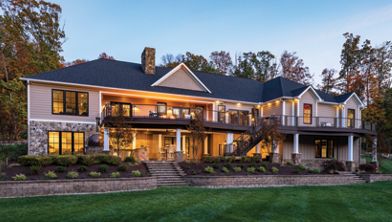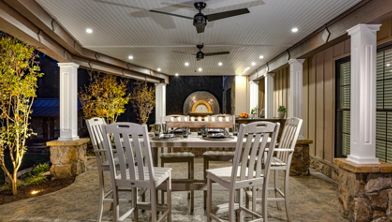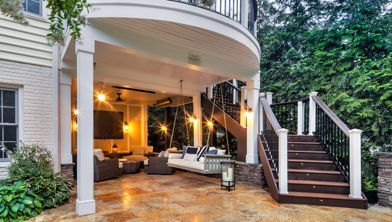For any home project, be certain to follow local code and permitting requirements.
Whether you’re looking to add ambience or functionality to your outdoor space, the right deck lighting is one of the most impactful enhancements you can make to your deck.
Learning how to install low-voltage deck lighting is fairly simple, provided only that you use a low-voltage lighting system and carefully read all manufacturer instructions.
The best part? And unless you need to run additional line-voltage circuits to feed a transformer, you probably won’t need an electrician or contractor for even a fairly elaborate deck lighting installation.
Develop a Lighting Plan
It's important not to skip over the planning phase when installing any low-voltage deck lighting — that way you can make sure the lights are properly positioned and connected to a 12V transformer.
Start by identifying the locations of AC power sockets for plugging in the transformer. These outlets must be ground fault circuit interrupters (GFCIs) — a type of outlet designed to automatically shut off power to avoid shocks and other hazards.
After you've identified your outlets, plan out the locations of your lights, power supply, timer, and dimmer. They should be in spots that are easily accessible for service. Dimmers should be placed in a dry location within a 30-foot radius of your power supply. Timers must be installed vertically with the receptacle facing downward and at least one foot from the ground, per federal safety code.
Once you've completed your plan, start measuring the approximate lengths of the necessary wiring to run your lights, and count the number of transformers you might need for your project.
Connect Your Transformer
Low voltage deck lighting systems will require a deck lighting transformer, which is used to convert the ordinary household “line voltage” (120V) produced by an electrical socket. Most installations call for 12V transformers, so you only have to concern yourself with ensuring the transformer you choose can withstand the total wattage of all connected lights (most manufacturers have more than one sized transformer).
Selecting a Transformer
One important note:Not all 12V transformers are created equal. Some, often less expensive transformers, are simple “step-down” units that simply take 120VAC and step it down to 12VAC. The other option is to use transformers that change the voltage type from AC (Alternating Current, like your home uses) to DC (Direct Current, like your mobile phone charger) while reducing the voltage from 120V to 12V.
It’s important to know which type of voltage (i.e. AC vs DC) your lighting fixtures take, as the wrong voltage type can cause major component failure and other performance problems (and may even void your warranty).
Also, it’s absolutely critical that you never mix AC and DC fixtures on the same circuit. For this reason, it’s highly recommended to use the same brand transformer as the light fixtures and to stick to one brand of fixtures.
When you're installing Trex® LED Deck Lighting™, keep in mind that Trex does not warrant or support the use of non-Trex transformers and dimmers. Use Trex transformers that are specifically designed for the voltage and type (DC) requirements of Trex lights to avoid potential component failures and warranty issues.
The transformer you choose will also determine how many lights can be connected to a single transformer. For example, a 8.3A transformer can power a maximum of 79 Trex LED Deck Lights, while a 2.5A transformer can power 27.
Trex also has an interactive onlineLighting Transformer Calculatorto help make sure you don’t overload the transformer. Overloaded transformers can fail prematurely and potentially cause fixture performance problems.
Ensuring Proper Wiring
One last power supply consideration: if you have an excessively long wire run (for example, over 300 feet) you might consider sourcing your own wire and stepping up to 16GA UL-listed outdoor rated 2 conductor wire. This can solve a problem called "voltage drop."
In basic terms, the longer the electricity has to run the more energy it loses at the end of the run. If you use a thicker (or lower gauge) wire you will minimise the chances that this can happen.
If the system you’re installing uses a proprietary plug and play installation system, it’s normally appropriate to cut and hardwire the connections (but always check with your manufacturer for more information).
Install Wire Splitters
Some systems, such as the Trex Lighthub® system, use wire splitters to eliminate the need for cutting and splicing. You’ll get a 5’ wire with each light fixture from Trex, so all you need to plan to buy are the splitters and the wires that connect each splitter together.
Wire splitters transform one female connection into several, which makes adding them necessary along every post base where you want lighting. When installing your wire splitters, there are few things you'll want to keep in mind:
- It's recommended that you install your splitters before adding decking or railing for easier access.
- Also, don’t fully attach the splitters to the joist. Leave them loose so you can manoeuvre them as you insert the Lighthub plugs.
- Don't use an extension cord between the electrical outlet and the transformer. Rather, connect the transformer directly with the power outlet. If the transformer cable does not reach the splitter, then you may need a wire extension cable, one which is designed to connect after the splitter.
- Lastly, you’ll need to ensure the circuit the lighting is installed on has active and functional GFCI protection. This helps ensure spikes and other electrical anomalies won’t fry your lighting system (although massive spikes like lightning strikes are impossible to fully protect against).
Staple Wiring to Deck Frame
Hiding away wiring is critical for both safety and aesthetics. In most circumstances, your best option is attaching the wiring directly to your deck’s frame – almost any place that’s out of sight.
When stapling your wiring, never drive staples all the way in. Your wire should be able to move under the staple to avoid potential issues. Always use cable-safe staples or fasteners. Typical metal staples (for example, T50 type) have a high likelihood of penetrating the insulation of the wire and causing shorts.
Make sure to run the wire under your decking structures and behind stringers. Running it between your deck boards and joists can lead to connection issues and could damage the wire.
Installing Your Deck Lighting
Depending on the type of deck lighting options you choose, there are some best practices to keep in mind when installing each one.
- Power on: The #1 tip for Trex® DeckLighting™, whether using plug and play or splicing wires, is to install with the power on. It’s essentially troubleshooting while installing.
- Check compatibility: Always check with the manufacturer if you plan to use a different brand - just to double check that this method is safe with their system.
To maximize value, consider premium options, such as the Trex® Deck Lighting™ dimmable and weather-proof features that can stretch the usefulness of your light fixtures.
Adding Post Cap Lights
Post cap lights offer a touch of illumination at the top of your railing. These lights are useful for those looking to show off the quality of the railing and add a vertical layer to their lighting setup. To install post cap lights, follow these steps:
- The wiring that powers post caps comes up from below your deck. It’s best if the post sleeve isn’t on the 4-inch-by-4-inch post when you feed the wire through. If your post is there, the process is much more difficult as the passage you have to run the wire is very small.
- Use a cable staple (or painter’s tape) to hold the included 5-foot wire in place.
- Install your railing system, post sleeve skirt, and the post sleeve over the post.
- Connect the wire under the deck to the splitter, then plug in the cap light, making sure it works before moving on.
Remember to leave slack in the wire toward the top of the post cap. Start with the post nearest to your power source, and finish by placing the sleeve back on the post. You can also try our Solar Post Cap Lights for a wireless option.
Incorporating Deck Rail Lights
Deck Rail Lights will generate indirect illumination from your railing, allowing you to show off your decking at night. To install post lights, you'll follow this multi-step process to avoid any potential issues:
- Before you install the railing, slide your post sleeve over the 4X4 wood post.
- Mark the desired height and location for the light on your post sleeve. Center the location on the post sleeve and place a deck board on your framing to ensure your sleeve is at the correct final height.
- Drill a 1-inch hole through the sleeve and into the wood post underneath with a Forstner bit. Drill a deep hole so the location will be marked on the post itself.
- Remove the sleeve from the post.
- Drill out the existing hole ¾ of an inch deep.
- Then drill a series of three one-inch holes in a vertical line to create space to tuck away the wire to run along the post, allowing the wiring to eventually connect with the splitter once the post lights are assembled. (Do not make this “pocket” horizontal, the screws that hold the post lamp will hit the wires and cause a short.)
- Leave enough slack at the top of the lead wire and attach it to the post using heavy-duty tape.
- Fish the wire under the deck, connect it to the splitter, slide the post sleeve back on and tuck the rest of the included 5-foot Lighthub® wire into the pocket. Connect the light, screw the base into the sleeve and rotate the lens cover in place.
Riser Lights
Different kinds of stairs and lighting fixtures can call for different kinds of installation. As long as you follow manufacturer recommendations, you can use your judgement about the placement or riser lights.
However, for most designs, risers are typically installed 4 inches above the track. Mark your selected location on the stair, then drill a 1 inch diameter hole to all the way through the riser. Feed wiring through the hole and connect the riser lighting cable to splitter behind the stairs.
Installing Riser Lights
Riser lights add a level of safety to your stairs without interfering with your overall visual style because they're tucked away. Different stairs and lighting fixtures can call for different installations. As long as you follow manufacturer recommendations, you can use your own discretion when choosing the placement or riser lights. For most designs, risers are typically installed 4 inches above the track. Follow these instructions when it comes time to install your riser lights:
- Mark your selected location on the stair.
- Drill a 1-inch diameter hole all the way through the riser.
- Feed wiring through the hole and connect the riser lighting cable to the splitter behind the stairs.
Recessed Deck Lights
Identify the deck board where you want to install thre recessed lighting. Avoiding joists, drill a hole with 1 inch diameter through the chosen board. The depth of the hole should match the depth of the lighting fixture you’ve selected, which will allow the lights to rest perfectly recessed in your deck. Drill an additional 1/4 inch hole to feed wiring. Be sure that the light remains flush against the boards before finalising the installation.
Make sure if the install temperature is warm that the light fixture slides in place. If you have to tap or mallet it in place when the board is hot, the board can deform the light when the weather turns cold. Also, if you accidentally make the hole too big, simply add a dab of silicone to the side of the light to keep it in place.
Close Off Unused Connections
After you’ve finished connecting your lights, you may still have unused female power connections. Unused splitter ports can be vulnerable to the elements, so all unused female connections should be closed using the plastic caps provided by the manufacturer.
Get Started on Installing Deck Lighting
Installing low-voltage deck lighting is an inherently safer choice, and it makes decking light installation about as simple as plugging in a lamp. If you’re ready to start exploring your options for installing deck lights, take a moment to find a local Trex Dealer who can help.
More Resources to Explore
This content was partially or fully generated by AI and has been reviewed by our team to ensure accuracy and relevance.





































